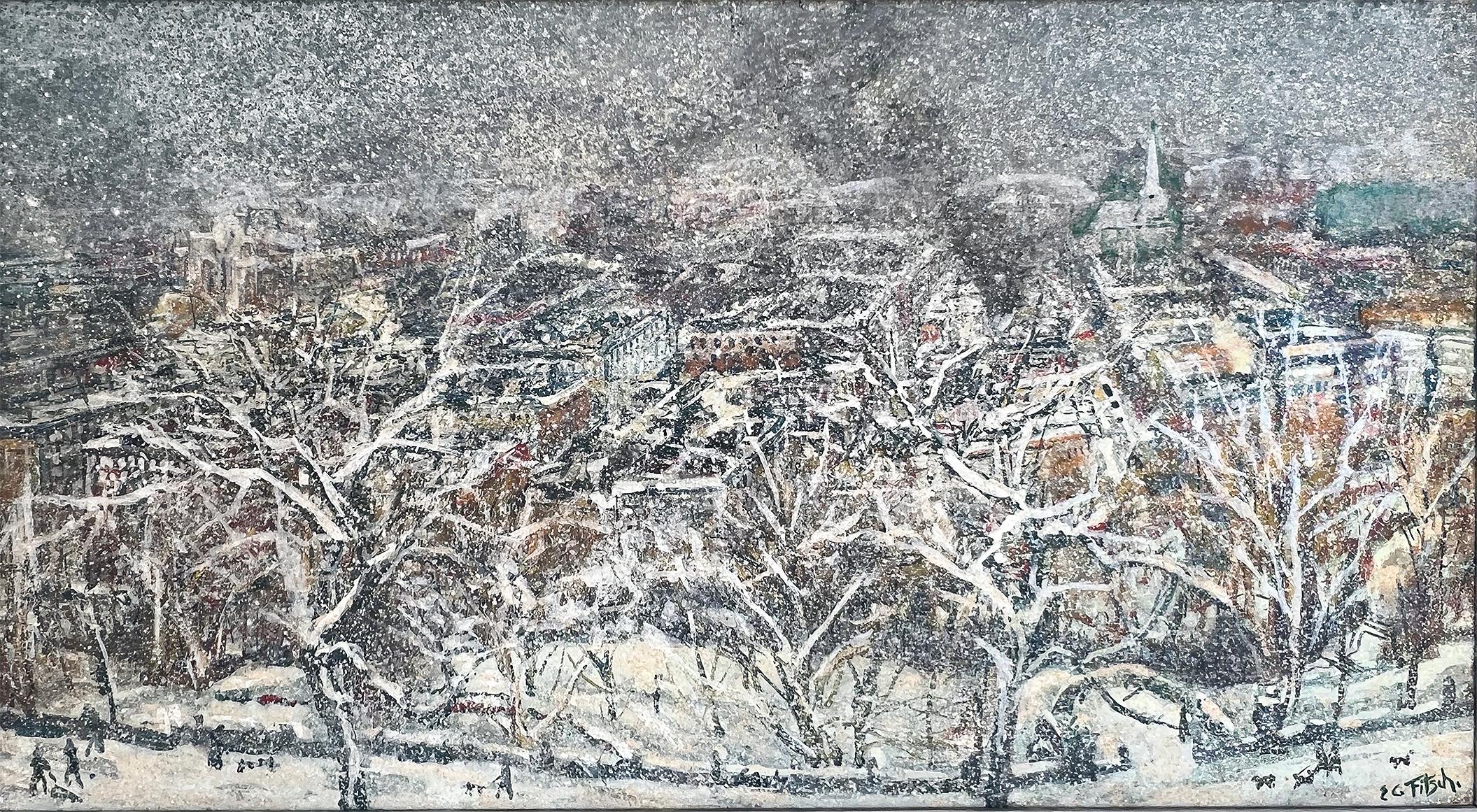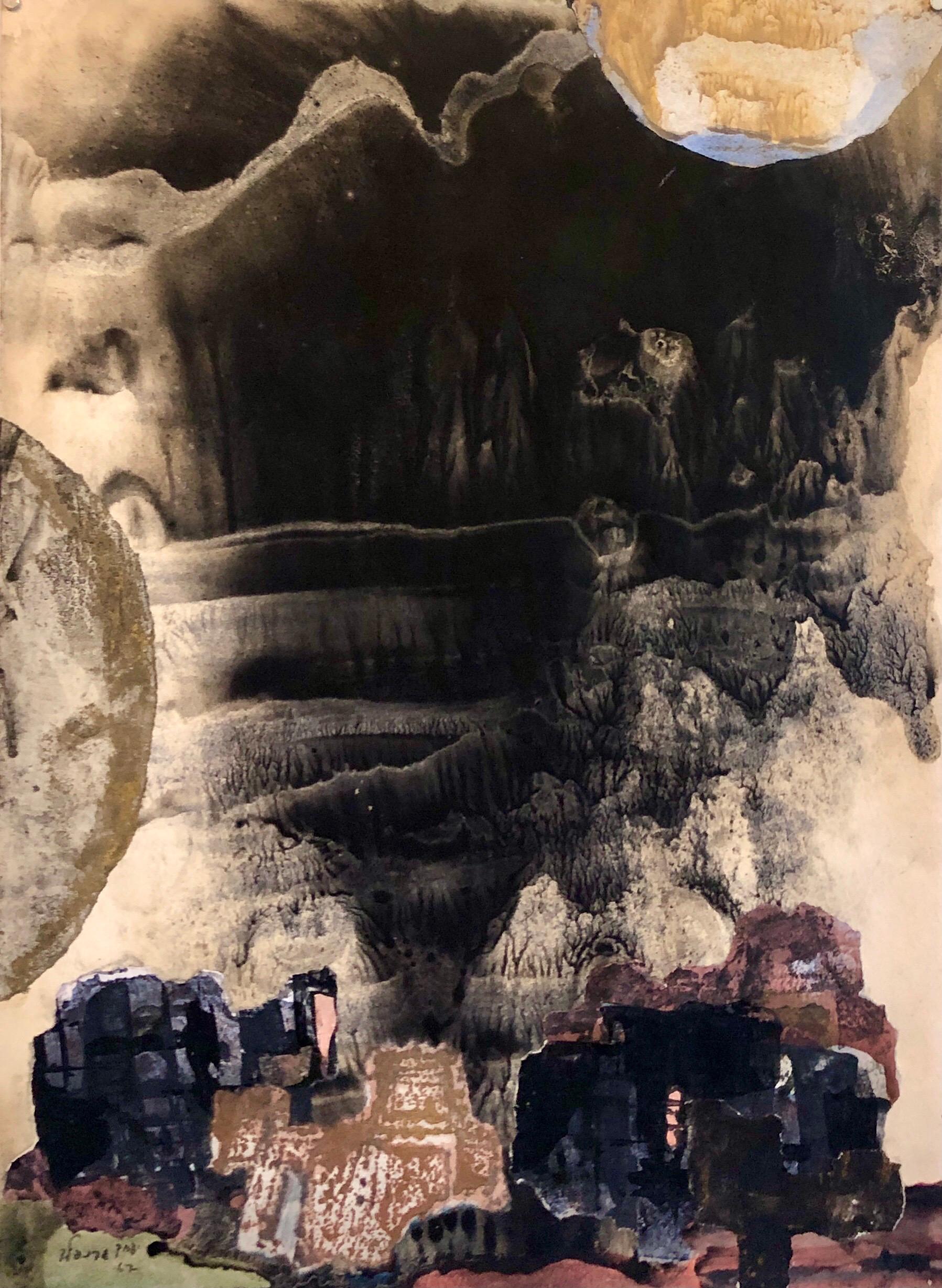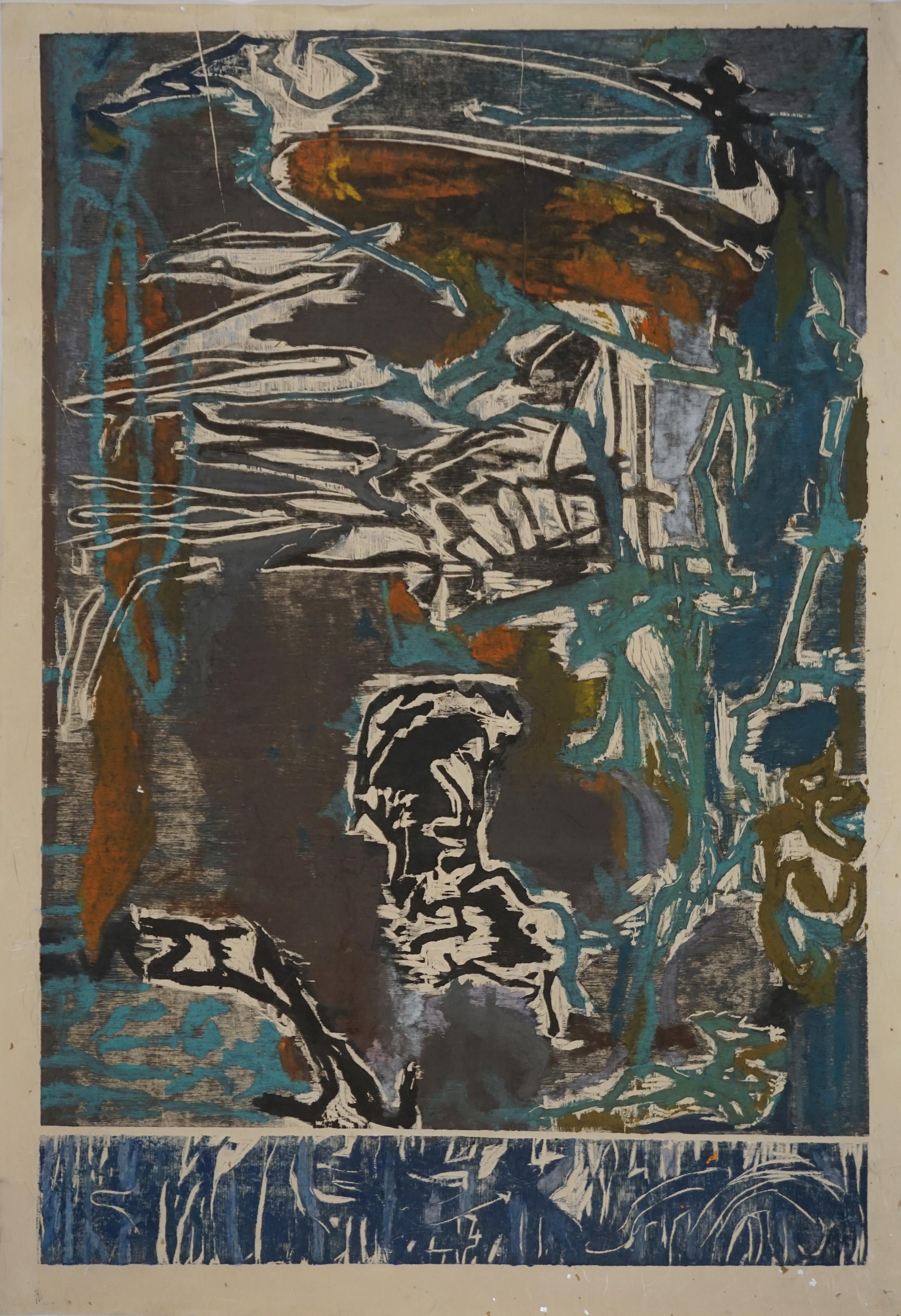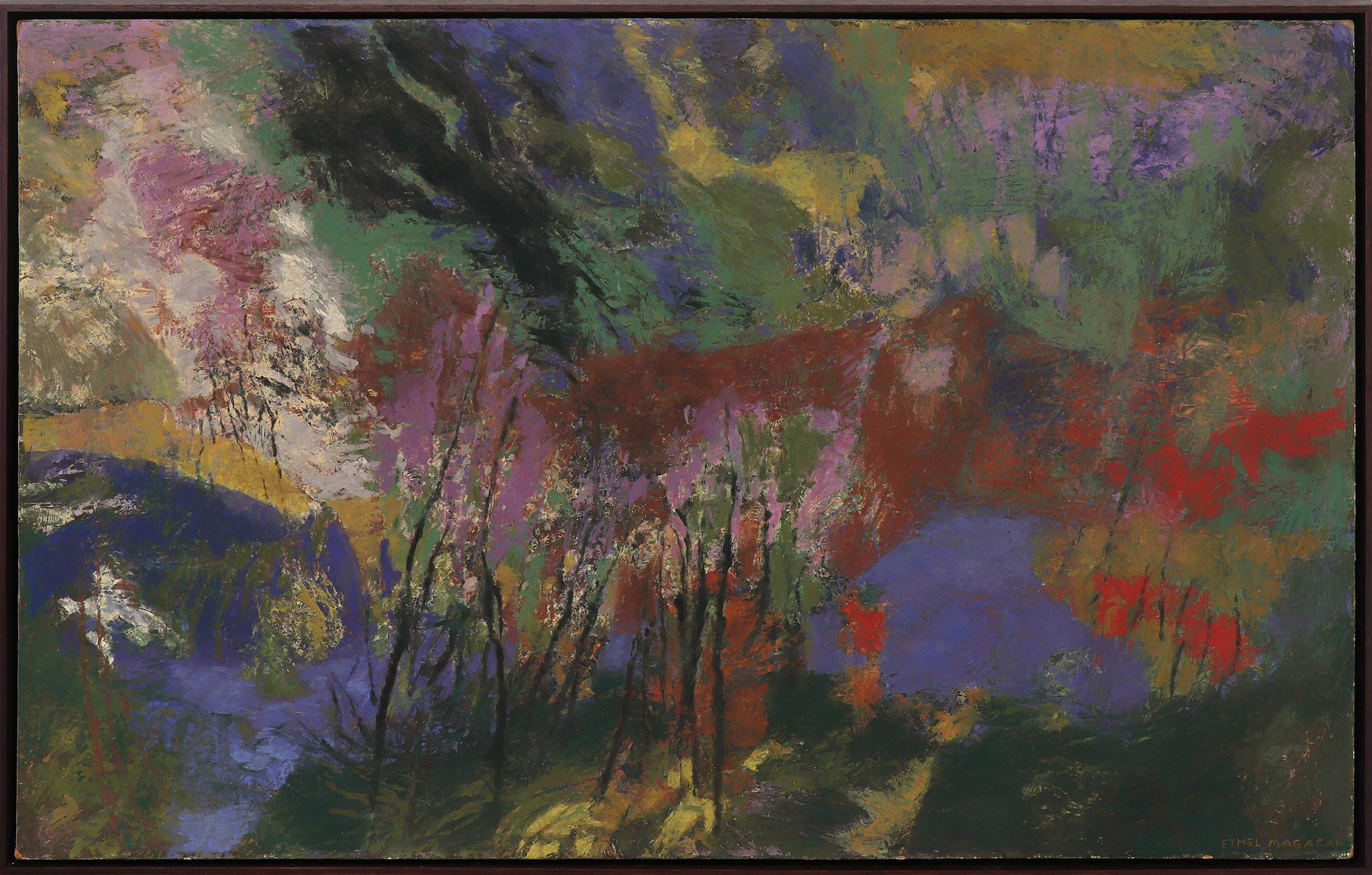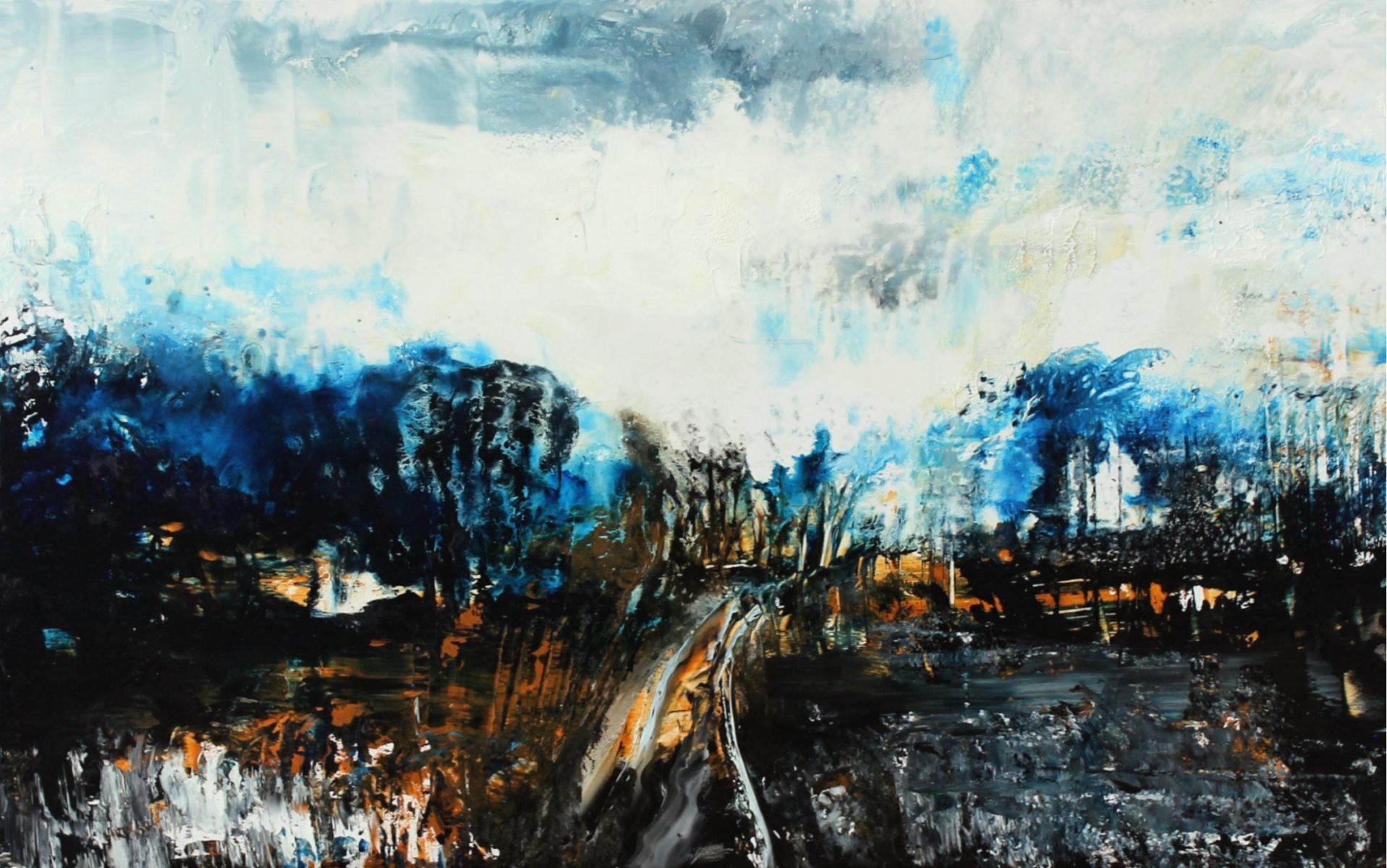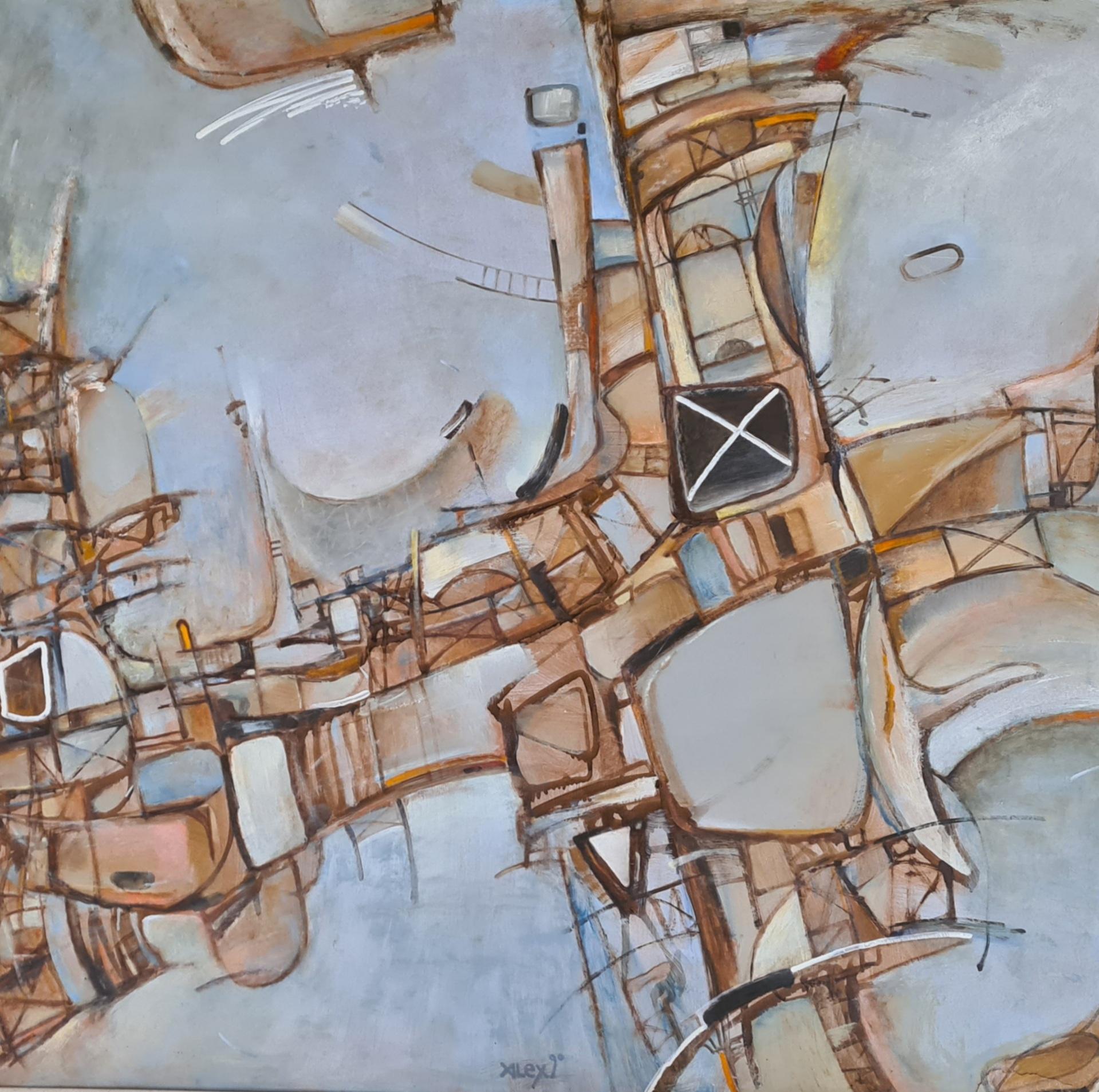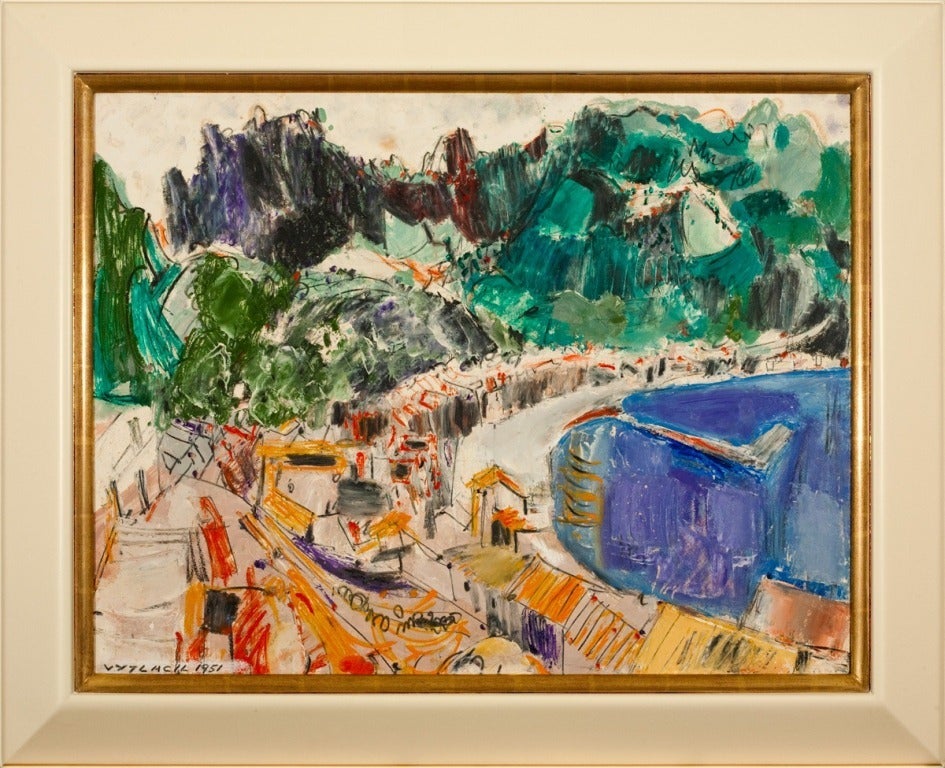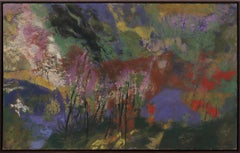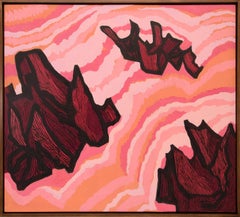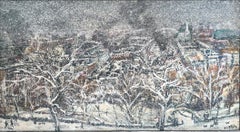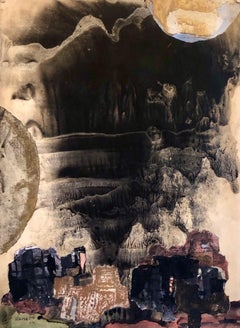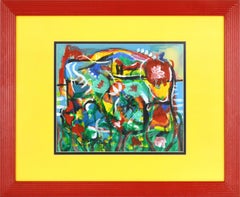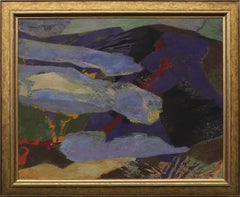
Morning Clouds, 1970s Semi Abstract Mountain Landscape Tempera Painting
View Similar Items
Video Loading
Want more images or videos?
Request additional images or videos from the seller
1 of 18
Ethel MagafanMorning Clouds, 1970s Semi Abstract Mountain Landscape Tempera Paintingcirca 1960-1970
circa 1960-1970
About the Item
- Creator:Ethel Magafan (1916-1993, American)
- Creation Year:circa 1960-1970
- Dimensions:Height: 40 in (101.6 cm)Width: 48.75 in (123.83 cm)Depth: 1 in (2.54 cm)
- Medium:
- Movement & Style:
- Period:
- Condition:
- Gallery Location:Denver, CO
- Reference Number:Seller: 262351stDibs: LU27310108172
About the Seller
5.0
Platinum Seller
These expertly vetted sellers are 1stDibs' most experienced sellers and are rated highest by our customers.
Established in 1979
1stDibs seller since 2013
264 sales on 1stDibs
Typical response time: 5 hours
More From This SellerView All
- Springtime, 1960s Semi Abstract Modernist Mountain Landscape Tempera PaintingBy Ethel MagafanLocated in Denver, CO"Springtime" is an original tempera on board painting of a Colorado mountain landscape painting by Ethel Magafan circa 1960. Abstracted mountain landscape with trees, painted in colors of green, purple, golden yellow, red, orange, blue, black and white. Presented in a custom hardwood frame, outer dimensions measure 23 ¼ x 50 x 2 inches. Image size is 30 x 48 inches. Provenance: Private collection, Maine Acquired in the early 1960s, by descent through the family to the present owner About the Artist: Jenne and Ethel Magafan were identical twins, born in Chicago to a Greek immigrant father and a Polish mother. Due to health concerns about their father, the family moved to Colorado, living first in Colorado Springs and then in Denver. He was a proud supporter of their artistic ambitions but died suddenly 1932, a heavy blow to both of them. They attended East High School in Denver, where they found a mentor in their art teacher Helen Perry. She had studied at the Art Institute of Chicago but had later abandoned a career as an artist, making her all the more determined to help the Magafan twins succeed artistically. While still in high school, the twins impressed artist Frank Mechau, and Helen Perry paid for their lessons with him. He subsequently invited them to apprentice with him at his Redstone studio. In 1936, Jenne won the Carter Memorial Art Scholarship and shared it with her sister so that they both could attend the Broadmoor Art Academy in Colorado Springs. Once they ran out of money, Mechau, now teaching there, hired them as assistants. Through their involvement at the Academy, the twins entered into careers as muralists, working at first with Mechau and then with Peppino Mangravite. From 1937 to 1943, Ethel was commissioned to paint her first of seven government sponsored murals. Located in the US Post Office in Auburn, Nebraska, this commission made Ethel (at age 26) the youngest artist in America to receive such an honor. Denver Art Museum director Donald J. Bear once commented that “[Ethel and Jenne's] study of local detail makes them appear as little Bruegels of ranch genre – natural and unforced.” As mural painting commissions diminished, Ethel began to do more easel painting for which she used a palette knife and tempera paints to great effect. After settling in California for five years, the twins permanently relocated to Woodstock, New York in 1945, where the sisters lived apart for the first time. Ethel developed an increasing focus within her work, particularly for horses and abstract landscapes. She met fellow artist Bruce Currie...Category
Mid-20th Century American Impressionist Abstract Paintings
MaterialsTempera, Board
- Jagged Sea, 1960s Abstract Landscape Painting, Tones of Pink, Red, OrangeBy Margo HoffLocated in Denver, COAbstract acrylic on board painting by Margo Hoff (1910-2008) titled 'Jagged Sea'. Outer dimensions measure 37.5 x 41.5 x 2 inches. Image dimensions measure 36 x 40.25 x 1 inches. Provenance: Estate of the artist Painting is in good condition - please contact us for a detailed condition report. About the Artist: Born Oklahoma 1910 Died New York 2008 A prolific artist, Margo Hoff’s exquisite style evolved throughout her career yet was always rooted in the events, people, and places in her life. The human experience was her sole focus, expressed through her eyes alone. Born in 1910 in Tulsa, Oklahoma, Hoff began creating white, clay animals at a young age, giving them to her friends and family. At eleven she contracted typhoid fever and was bedridden for a summer. During her convalescence, she drew and made cutouts, and it was during this time that her bold, artistic imagination came alive. She began formal art training in high school and continued her education at the University of Oklahoma, Tulsa. In 1933 she moved to Chicago and attended the National Academy of Art and the School of the Art Institute of Chicago. Between 1933 and 1960, her Chicago years, Hoff’s work was deeply rooted in a figurative, regionalist style. She often used elements of magical realism, and many of her paintings have dreamlike qualities. As a child she learned about color by grinding down rocks, plants, and berries. Her color pallet during the Chicago years is indicative of her early, life color experimentation as she consistently used warm, earth tones in her work. Hoff was a born adventurer and traveled extensively. She lived, worked, taught, and painted in Europe, Mexico, Lebanon, Uganda, Brazil, and China. She also showed at the Denver Art Museum’s Annual Western Exhibitions in 1952, 54, 56 and 57. In 1957 she showed along-side Colorado modernist Vance Kirkland at the Denver Art Museum’s exhibition, Man’s Conquest of Space. What was once a focus on the representational, her work began to change after 1957 when she saw Sputnik in its orbit around Earth. At that moment, feet firmly placed on the ground, she was able to imagine herself in space, looking down from the cosmos, and what she saw was an abstracted world. She then had the opportunity to peer into an electron microscope where once again she was looking down into what seemed to be a realm of pure abstraction. These two events profoundly changed her perspective and she began to move from figural painting to abstract, geometric collage. In 1960, Hoff moved to New York City and she began creating collages. Placing the canvas on the ground, and working from all sides, she used strips of painted paper and tissue, and later painted pieces of canvas, glued onto the canvas surface, building layer upon layer, shape against shape, “action of color next to stillness of color.” She believed these simplified, abstracted forms held the spirit of the subject in the same way poetry reduces words to their essence. These pieces range from aerial cityscapes, to dancers in motions, to flora...Category
1960s Abstract Landscape Paintings
MaterialsAcrylic, Board
$7,996 Sale Price20% Off - 1945 Abstract Landscape with Waterfall Watercolor Painting, Modernist LandscapeBy Eve DreweloweLocated in Denver, COWatercolor on paper painting by Eve (Van Ek) Drewelowe titled "The Champagne Cascades, Crescendos, Crashes" from 1945. An abstract landscape scene of a waterfall with white, yellow, and black. Presented in a custom gold frame, outer dimensions measure 43 ¾ x 33 ¾ x ½ inches. Image size is 29 ¾ x 19 ¾ inches. Painting is clean and in very good vintage condition - please contact us for a detailed condition report. Provenance: Private collection, Denver, Colorado Expedited and international shipping is available - please contact us for a quote. About the Artist: A painter and sculptor, Eve Drewelowe was the eighth of twelve children and grew up on a farm with a tomboyish spirit. Her farm duties did not permit her to take art classes in her youth that she later felt would have hindered the development of her artistic style. Although her father died when she was eleven, he imparted to her reverence for nature and a true love of the earth, values later reflected in her western oil and watercolor landscapes. She attended the University of Iowa at Iowa City on scholarship, receiving her B.A. degree in graphic and plastic arts in 1923. After graduation and against the advice of her art professor, Charles Atherton Cumming who believed that matrimony ended a woman’s painting career, she married fellow student Jacob Van Ek. While he pursued his doctorate in political science, she enrolled in graduate school at the University of Iowa for her M.A. degree in painting and the history of art. At that time her alma mater was one of the few universities in the United States offering an advanced fine arts degree, and she was its first graduate, receiving her degree in 1924. That year the Van Eks moved to Boulder, Colorado, where Jacob had obtained a position as an assistant professor at the University of Colorado. Five years later he became the Dean of the College of Arts & Sciences, a position he held until 1959. Eve briefly studied at the University. In 1927 and 1928 she taught part-time at the University’s School of Engineering and a decade later summer courses (1936 and 1937) in the University’s Department of Fine Arts. In 1926 she became a charter member of the Boulder Artists Guild and participated in its inaugural exhibition. Like many American artists of her generation, she helped foster an art tradition outside the established cultural centers in the East and Midwest. Her professional career spanning six decades largely was spent in and around Boulder. There she produced more than 1,000 works of art in oil, watercolor, pen and ink, and other media in styles of impressionism, regionalism, and abstraction. She devoted a considerable part of her work to Colorado, Wyoming, and Arizona subject matter depicting colorful and fantastic landscapes pulsating with energy and untouched by humans. Excited by what she saw, the wide open spaces made her feel like a modern-day pioneer. In discussing her work, she once said, “What really motivated me in my youth, in my growth, in maturity was my desire to captivate everything. I put on canvas an eagerness to possess the wonder of nature and beauty of color and line – to encompass everything, not to let anything escape.” Before World War II she and her husband took two international trips that had far-reaching consequences for her career, exposing her to the arts and cultures of countries in Asia and Europe. The first in 1928-29 was an extensive excursion in the Far East for which her husband had received a scholarship to study and report on the socioeconomics of Japan, Korea, China, the Philippines, the Dutch East Indies and India. The year after their return she had her first solo show at the University of Colorado’s library gallery. Discussing the twenty-six oils and sixteen ink drawings on view representing sixteen different countries, the Christian Science Monitor reviewer noted: “The pictures have a wide range and are far from being stereotyped in subject matter, being personal in choice. The ink-brush drawings are spontaneous, well balanced, and striking in their masses, giving the sense of having been done on the spot.” Her second trip with her husband and a party from the Bureau of University Travel had a four-month itinerary that included England, Denmark, Finland, Russia, Turkey, Greece, Italy, and France. It yielded seventeen oils and twenty-six ink-wash drawings which she exhibited in a February 1936 solo show at the Boulder Art Association Gallery. Her creative output in the 1930s attracted the attention of the critic for the Parisian Revue des Arts whose observations were translated and printed in the Boulder Daily Camera on June 10, 1937: To present our readers Eve Van Ek [at that time she signed her work with her married name] …is to give them an opportunity to admire a talent of multiple aspects. The eclecticism of her art passes from a rich skill in forceful oil painting of fine strokes of precision best seen perhaps in her treatment of mountain subjects, of craggy cliffs hewn as in nature, through pen and ink or lithographic crayon design, water color, and occasionally embroidery and sculpture, to the delicate perfection of detail of the miniature. The lofty mountains of Colorado have supplied her with extremely interesting subjects for study; she knows how to represent in an entirely personal way the varying scenes and the curious restlessness of the terrain. While pursuing her art, she also was a dean’s wife. The responsibilities attached to that position proved too restrictive, contributing to a grave illness. She underwent an operation in 1940 at the Mayo Clinic for a gastric polyp, a dangerous procedure at that time. Although she had expected to come back to Boulder “in a box,” the surgery proved successful. Depicting her painful hospital stay in a watercolor, Reincarnation, she reflected on the transformative experience of piecing her life back together. That October she received encouragement from the review of her solo exhibition at the Argent Gallery in New York written by Howard Devree, art critic for the New York Times who said: “The whole exhibition is stimulating…Boats, fences and even flowers in the canvases of Eve Van Ek…seem struggling endlessly to escape from the confines of the frame.” Her watercolor, Crosses, Central City (1940), illustrates her work described in the New York review. The composition pulsates with energy conveyed by the modernist technique of juxtaposing the scene’s various angles, distorting the shapes and positions of the structures, additionally highlighting them with bright colors. The telephone poles at various angles represent crosses figuratively marking a Way of the Cross symbolized by the wooden stairs...Category
1940s Abstract Landscape Paintings
MaterialsPaper, Watercolor
- Abstract Colorado Mountain Landscap, Modernist Painting Green Pink BlueBy Zona WheelerLocated in Denver, COOriginal 1949 mid-century modern semi-abstract painting of Colorado Mountains by Kansas woman artist, Zona Wheeler (1913-1998) with shades of gree...Category
Mid-20th Century Abstract Abstract Paintings
MaterialsOil
- Mesa Verde, 1980s Abstract Landscape Oil on Canvas Painting, Yellow, Pink, GoldLocated in Denver, COAbstract oil on canvas signed and titled 'Mesa Verde' by Wilma Fiori (1929-2019) painted November 17, 1988. Painted in bright yellows, gold, pink, red, and...Category
1980s Abstract Abstract Paintings
MaterialsCanvas, Oil
- Mid Century Modern Abstracted Cityscape Oil Painting, American Modern, Red BlackLocated in Denver, COMid 20th century oil and spackle painting featuring an abstracted cityscape with a bridge and buildings by Henriette "Yetti" Stolz. Signed by the artist in the lower right margin. Pa...Category
Mid-20th Century American Modern Abstract Paintings
MaterialsOil, Board, Putty
You May Also Like
- Snowstorm, Morningside Heights, New York City - MonochromaticLocated in Miami, FLEugene Camille Fitsch Am./Fr., 1892-1972 - Signed lower right. Framed dimensions 20 3/4" x 34 7/8" framed Provenance: Studio of the Artist to Private Collection Boston, Massachuse...Category
1940s Abstract Expressionist Landscape Paintings
MaterialsCasein
- Kibbutz Abstract Jerusalem Nightscape Israeli Tempera Collage Painting JudaicaLocated in Surfside, FLAbstract Expressionist cityscape of Old City of Jerusalem in moody blues and gold. Yitzhak Greenfield, painter, born 1932, Brooklyn, New York His fo...Category
1960s Abstract Expressionist Landscape Paintings
MaterialsMixed Media, Tempera
- Spring Awakening, Abstract Expressionist Figurative Garden by Dana WegterLocated in Soquel, CAHighly energetic and abstracted garden flowers and the hint of a figure emerge from this abstract expressionist explosion of color and form, by Dana Wegter (American, 20th-21st Century), 2000. Signed and dated "Dana Wegter '00" lower right. Displayed in a bright yellow mat...Category
Early 2000s Abstract Expressionist Abstract Paintings
MaterialsPaper, Tempera
- Vintage Original Abstracted Landscape Silk Screen on Japanese Rice PaperLocated in Soquel, CAVintage Original Abstracted Landscape Silk Screen on Rice Paper Dramatic non-objective and abstracted landscape silkscreen in black india ink and neutral Casein paint tones. Unsigne...Category
1970s Abstract Expressionist Abstract Paintings
MaterialsInk, Casein, Rice Paper
- Mid Century Abstract Original Painting - Blue Calligraphy on Crimson WaterBy Honora BergLocated in Soquel, CAMid Century Abstract Original Painting - Blue Calligraphy on Crimson Water in Oil and Tempera on Paper Wonderful Bay Area abstract composition by San Francisco's artist Honora Berg ...Category
1940s Abstract Expressionist Abstract Paintings
MaterialsPaper, Oil, Tempera
- Landscape - XXI century, Contemporary Oil & Acrylic Painting, AbstractionBy Monika RossaLocated in Warsaw, PLMONIKA ROSSA studied painting at the University of Arizona, in the Ecole des Beaux Arts in Paris and at the Escuela de Diseno in Barcelona. She practices drawing and easel painting....Category
21st Century and Contemporary Abstract Abstract Paintings
MaterialsOil, Acrylic, Board
Recently Viewed
View AllMore Ways To Browse
New Orleans Vintage Posters
New Orleans Vintage Poster
Tiffany Co Locations
Tiffany And Co Locations
Retro Camping Poster
Spring Morning Paris
Retro Chicago Travel Poster
Notre Dame De Paris Painting 1950s
Polish Travel Poster
Vintage 1940s Summer Dress Dresses
Tiffany And Co Man
Vintage Mirror Ball
Tiffany Horse
20s Fashion Sketch
Retro New Orleans Poster
Vintage Art Supplies 1940s
Norman Irving
Fred Jones
